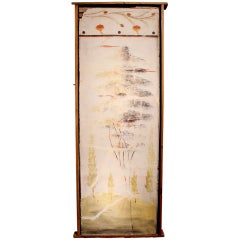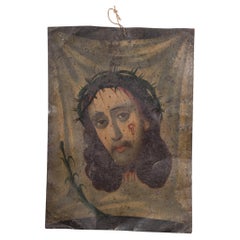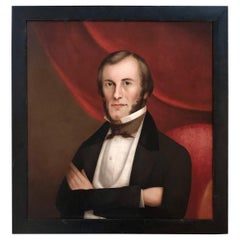Rufus Porter Folk Art
to
1
1
1
1
1
1
1
1
1
1
236
104
96
86
Creator: Rufus Porter
Rufus Porter Mural from New Hampshire Tavern
By Rufus Porter
Located in Milford, NH
Mural by Rufus Porter from Prescott Tavern in East Jaffrey, New Hampshire, circa 1824. This panel was removed from the tavern prior to its being torn down in 1950. This mural hung in...
Category
19th Century American Folk Art Antique Rufus Porter Folk Art
Related Items
19th c. Mexican Retablo "Veronica's Veil" c.1880
Located in San Francisco, CA
ABOUT
An original 19th century Mexican folk retablo "Veronica's Veil" or "El Divono Rostro" in Spain . Oil paint on tin.
The Veil of Veronica, known in Italian as the Volto Santo or Holy Face, is a Roman Catholic Relic which, according to legend, bears the likeness of the Face of Jesus that was imprinted on it prior to Jesus' crucifixion. According to Roman Catholicism, Saint Veronica encountered Jesus in Jeruselum on the way to Calvary. When she paused to wipe the sweat (Latin, suda) off his face with her veil, his image was left on the veil.
In the small village of Osa de la Vega in Spain, there lived a couple who led a very pious life. They were Gregorio de la Torre and Isabel Corral. From their father, Juan Montilla, they inherited a picture of the Face of Jesus or the Divino Rostro. A story that is told one day, to the amazement of many who confirmed its veracity, the picture began to perspire with living blood. News of this extraordinary event spread swiftly and widely throughout the land.
CREATOR Unknown.
DATE OF MANUFACTURE c.1880.
MATERIALS AND TECHNIQUES Oil Paint on Tin.
CONDITION Good. Wear consistent with age and use.
DIMENSIONS H 14 in. W 10 in.
HISTORY
Retablos, better known as 'laminas' in Mexico, are small oil paintings on tin, wood and sometimes copper which were used in home altars to venerate the almost infinite number of Catholic saints. The literal translation for 'retablo' is 'behind the altar.' This unique genre of art, deeply rooted in European history, was brought to Mexico with the arrival of the Spanish and then ultimately adopted by New World mestizo natives to become what is known today as the Mexican folk retablo.
The retablo was an art form that flourished in post conquest Mexico and then ultimately, with the introduction of inexpensive mediums such as tin, reached its pinnacle of popularity in the last quarter of the 19th century. With some exceptions, mostly untrained artists from the provinces worked to produce and reproduce these sacred images; some subjects painted more prolifically than others. A typical "retablero" may have reproduced the same image hundreds, if not thousands of times in his or her career.
These oil paintings were sold to devout believers who displayed them in home altars to honor their patron saints. There are virtually hundreds of saints, each invoked to remedy a different situation. "San Ysidro Labrador," the patron saint of farmers, is venerated for good weather...
Category
19th Century Mexican Folk Art Antique Rufus Porter Folk Art
Materials
Tin
19th Century Folk Art Painting of a Gentleman Attributed to Horace Bundy
Located in Wiscasset, ME
Oil on canvas, inscribed on the stretcher bar reverse.
The painting is presented in a flat black frame that complements it well.
Horace Bundy was an it...
Category
1830s American Folk Art Antique Rufus Porter Folk Art
Materials
Canvas, Paint
$2,400 Sale Price
38% Off
H 30 in W 28 in D 1 in
Whimsical Outsider, Folk Art Oil Painting by William R. Straly
By William R. Straly
Located in Buffalo, NY
Whimsical outsider, Folk Art oil painting by William R. Straly, excellent use of color. Texture and space.
Category
20th Century American Folk Art Rufus Porter Folk Art
Materials
Paint
Vintage Large Balinese Painting on Silk from Ubud Bali
Located in North Hollywood, CA
Mid-20th century Balinese painting on silk fabric, framed.
Vintage large Balinese art painting, from Ubud, Bali acrylic on silk.
Beautiful artwork by the Indonesian artist from Ubud.
Painted in Peliatan, Ubud Bali by W. Kurpelir as signed on the bottom left hand corner.
Balinese Folk Festival ceremonial procession, Ink and acrylic paint on canvas.
Batuan painting evolved in the 1930s after a group of local villagers tested different forms with ink-washed paintings upon black backgrounds. These paintings often reveal Batuan’s cultural life, directly through their elements of line, shape, and tone. Meticulous design, craftsmanship, and strong visual impression are characteristic of the style.
The painting comprise individual shapes which are painted in a precise and systematic manner that does not leave any empty space. The complexity of the paintings is inevitable as each of the strokes, lines, gradations, the characters or the subjects forms a delicate unity that finely balances the figure-filled canvas. Various gradations of colors separate different sections of the painting. The landscape is enticing and endless.
About Bali Art...
Category
Mid-20th Century Balinese Folk Art Rufus Porter Folk Art
Materials
Silk
Large Hindu Mural Sized Pichhwal Painting on Silk Cloth C1970
Located in Port Jervis, NY
Large Mural sized hindu painting on silk cloth. Measures: 44.5 x 76 x 1.5. Framed in a Gilt wood frame.
Category
1970s Indian Anglo Raj Vintage Rufus Porter Folk Art
Materials
Silk, Hardwood, Giltwood, Paint
Large Vintage Balinese Painting on Silk from Ubud Bali 1960's
Located in North Hollywood, CA
Mid 20th Century Balinese Painting on silk fabric, Framed.
Vintage large Balinese art painting, from Ubud, Bali acrylic on silk.
Beautiful artwork by the Indonesian artist from Ubud.
Painted in Peliatan, Ubud Bali by VJ. Kupur as signed on the bottom left hand corner.
Balinese Folk Festival ceremonial procession, Ink and acrylic paint on canvas.
Batuan painting evolved in the 1930s after a group of local villagers tested different forms with ink-washed paintings upon black backgrounds. These paintings often reveal Batuan’s cultural life, directly through their elements of line, shape, and tone. Meticulous design, craftsmanship, and strong visual impression are characteristic of the style.
The painting comprise individual shapes which are painted in a precise and systematic manner that does not leave any empty space. The complexity of the paintings is inevitable as each of the strokes, lines, gradations, the characters or the subjects forms a delicate unity that finely balances the figure-filled canvas. Various gradations of colors separate different sections of the painting. The landscape is enticing and endless.
About Bali Art...
Category
Mid-20th Century Balinese Folk Art Rufus Porter Folk Art
Materials
Silk
Surreal Figurative Painting, Roland Gautier
Located in London, GB
A large oil painting on ply board by French artist Roland Gautier. A surreal figurative observation of two forms with floating heads. A bold piece of qui...
Category
Late 20th Century French Folk Art Rufus Porter Folk Art
Materials
Plywood, Paint
Set of 6 Modernist Folk Art Oil on Wood Paintings Hand Executed by Endi Poskovic
By Fendi
Located in Buffalo, NY
Wonderful set of 6 original oil paintings by Endi Poskovic. These works recently acquired from old warehouse space in Buffalo NY, apparently a studio spa...
Category
1990s American Folk Art Rufus Porter Folk Art
Materials
Wood, Paint
$1,430 / item
H 48 in W 12.5 in D 1 in
Large Oil Painting on Canvas, Modernist Abstract, by Jim Bray, circa 1963
By Jim Bray
Located in Buffalo, NY
Large oil painting on canvas. Modernist Abstract, by Jim Bray, circa 1963. Charming image. Child-like. Great use of color, texture, space.
Category
1960s American Folk Art Vintage Rufus Porter Folk Art
Materials
Canvas, Paint
$3,200
H 43 in W 50 in D 2 in
Surreal Painting, Roland Gautier
Located in London, GB
A large oil painting on ply board by French artist Roland Gautier. A surreal figurative observation of the female form facing a male body in the foreground. Colourful and bold with a...
Category
Late 20th Century French Folk Art Rufus Porter Folk Art
Materials
Plywood, Paint
Pair of Vera Alabaster 'Russian' Original Folk Art Oil Paintings on Canvas
Located in Hamilton, Ontario
This pair of oil paintings on canvas are done by the well known portrait and landscape Russian artist, Vera Alabaster in circa 1940 in a Folk Art style. The paintings depict a Jamaic...
Category
Early 20th Century Russian Folk Art Rufus Porter Folk Art
Materials
Canvas
$4,450 / set
H 25.5 in W 19.5 in D 1 in
Untitled, Purvis Young Mixed-Media Painting, 1980s
By Purvis Young
Located in Miami, FL
Abstract mixed-media work by artist Purvis Young. Folk Art portraying bleeding and pregnant figures in a crowd, policemen on horseback and large blue eyes. Young used eyes as symbols...
Category
1980s American Folk Art Vintage Rufus Porter Folk Art
Materials
Paint, Reclaimed Wood, Canvas, Paper
Rufus Porter folk art for sale on 1stDibs.
Rufus Porter folk art are available for sale on 1stDibs. There are many options to choose from in our collection of Rufus Porter folk art, although beige editions of this piece are particularly popular. Many of the original folk art by Rufus Porter were created in the folk art style in united states during the 19th century. If you’re looking for additional options, many customers also consider folk art by Purvis Young, Ira Yeager, and Louis Marx and Company. Prices for Rufus Porter folk art can differ depending upon size, time period and other attributes — on 1stDibs, these items begin at $18,000 and can go as high as $18,000, while a piece like these, on average, fetch $18,000.


